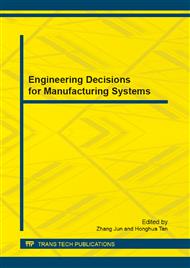[1]
T. Özel and X. Liu: Investigations on Mechanics Based Process Planning of Micro-End Milling in Machining Mold Cavities, Materials and Manufacturing Processes, Vol. 24, No. 12, (2009), pp.1274-1281.
DOI: 10.1080/10426910903130008
Google Scholar
[2]
M. A. Elbestawi, L. Chen, C. E. Becze, T. I. EI-Wardany: High-Speed Milling of Dies and Molds in their Hardened State, Annuals of CIRP, Vol. 46, (1997), pp.57-62.
DOI: 10.1016/s0007-8506(07)60775-6
Google Scholar
[3]
R. Ramesh, M. A. Mannan, and A. N. Poo: Error Compensation in Machine Tools – A Review Part I: Geometric, Cutting-Force Induced and Fixture Dependent Errors, International Journal of Machine Tool & Manufacture, Vol. 40, (2000), pp.1235-1256.
DOI: 10.1016/s0890-6955(00)00009-2
Google Scholar
[4]
C. J. Kim, J. R. Mayor and J. Ni: A Static Model of Chip Formation in Microscale Milling, Trans. ASME Journal of Manufacturing Science and Engineering, Vol. 126, (2004), pp.710-718.
DOI: 10.1115/1.1813475
Google Scholar
[5]
T. A. Dow, E. L. Miller and K. Garrard: Tool Force and Deflection Compensation for Small Milling Tools, Precision Engineering, Vol. 28, (2004), pp.31-45.
DOI: 10.1016/s0141-6359(03)00072-2
Google Scholar
[6]
H. Suzuki, T. Moriwaki, T. Yamamoto and Y. Goto: Precision Cutting of Aspherical Ceramic Molds with Micro PCD Milling Tool, CIRP Annals - Manufacturing Technology, Vol. 56, (2007), pp.131-134.
DOI: 10.1016/j.cirp.2007.05.033
Google Scholar
[7]
K. Popov and P. Petkov: Layer Based Micro-Machining-New Approach for Tool Pass Generation, CIRP Journal of Manufacturing Science and Technology, Vol. 4, (2011), pp.370-375.
DOI: 10.1016/j.cirpj.2011.03.010
Google Scholar
[8]
T. Moriwaki: Multi-functional Machine Tool, Annals of CIRP, Vol. 57, No. 2, (2008), pp.736-749.
DOI: 10.1016/j.cirp.2008.09.004
Google Scholar
[9]
I. Lazoglu, Y. Boz and H. Erdim: Five-Axis Milling Mechanics for Complex Free From Surfaces, CIRP Annals - Manufacturing Technology Journal, Vol. 60, (2011), pp.117-120.
DOI: 10.1016/j.cirp.2011.03.090
Google Scholar


